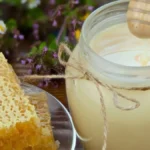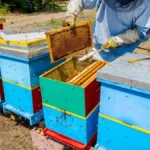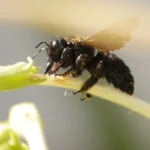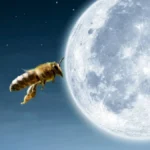Bees are able to partially regulate their body temperature and can fly for short periods at temperatures below 55°F. At what temperature do bees come out? It is important to differentiate between the temperature when they can forage, and the temperature when they can shoot out to sting or take a “cleansing flight”.
Bees and wasps have a lot in common in terms of how their metabolism works. Bees are in fact a type of wasp that has evolved to eat pollen, not flesh. We have reviewed how temperature and wasps work here. In that article, we showed how wasps do not have the ability to store sugar. When they have access to food brought in by foragers, they can generate a certain amount of heat in their nest, and this allows them to be active. However, because they do not have stored energy in their nest when temperatures drop below the minimum at which they can generate heat sustainably, the nest will starve. While they approach starvation they will get desperate and even destroy beehives to raid the nutrients in the bees and hive.
Bees are different – let us see why.
Honey = Stored Energy = Stored Heat
Bees store honey as a backup energy store. They can convert this stored energy, through their metabolism, into various forms of action in the hive. One of these forms of activity is to generate heat. This means that bees can consume honey and maintain high temperatures in the hive. This makes them less dependent on external factors for them to be able to fly and perform certain functions. At what temperature do bees come out is influenced by this.
The cluster inside a beehive is maintained at around 93°F when there is brood present. During the darkest coldest days of winter, brood rearing stops, and the hive cluster temperature will drop to 85°F. If we look at a bee when it ventures out into the air in the 50°F-55°F range, the bee will have been warmed up to flying temperature in the cluster. As it flies, its wing muscles generate heat, and some of this heat is lost to the air. The bee, in most cases, is unable to generate enough heat to keep the muscles warm enough to operate at maximum output, and it will fall to the ground. There are a few factors that affect this though.
Altitude
The higher you are above sea level, the thinner the air. Generally, the higher you go above sea level the cooler it gets too. However, cool thin high altitude air has less air in it, and hence it has less ability to remove heat from something that is warm. I have seen bees flying in Boulder Colorado, in February, when it had just snowed. The air in Boulder is sufficiently thin however that the bees are able to be warmed up by the cluster, and then dash out to the early poplars and other pollen sources. This allows them to rear a bit of brood and build up for spring.
At what temperature do bees come out at higher altitude is hence a bit lower than at sea level.
Humidity
Humidity increases the capacity of air to remove heat from an item. Again, using the Boulder, Colorado example – the air in February is so dry, and the air so thin at that altitude that your nose sort of dries out on the inside. For the bees, there is little humidity in the air to increase the air’s ability to remove heat. By contrast, at sea level in Portland Maine, at exactly the same temperature, the bees will not even think of leaving the hive because the air is dense, and humid and will cause them to get cold in a few seconds.
When asking “At what temperature do bees come out?” we can see that humidity plays a factor – lower humidity allows bees to emerge at lower temperatures.
Sunlight and Bee Color
The Sun actually transmits a significant amount of energy to small objects such as a bee. When I was working with Apis mellifera capensis bees we noted they have a significant phenotypic variation – some bees are pitch black, some are grey with stripes, and some may have one little yellow stripe at the end. Every now and then you pick up a bee with the more typical orange banded colors.

A dark Cape Honeybee – note the lack of orange stripes. This helps the bee absorb warmth on cold days. Photo courtesy of Dr. Jim Cambray.
I noticed on a cold winter’s day that these bees were flying. The hive we were observing was in a shaded spot and a lot of the bees were crashing into damp grass as they tried to enter the hive. When bees are cold it just takes a small bump to cause them to fall to the ground and more often than not they will then just die a slow death. The bees would however all try to climb to the top of grass stems and catch a little bit of Sunlight. After a few minutes, the black bees would be able to fly back into the hive, whereas the orange striped bees never absorbed enough heat to get back into the air and to their hive.
At What Temperature Do Bees Come Out
Now that we have looked at the mechanisms by which bees warm themselves, let us answer our burning question “At what temperature do bees come out?”
Minimum Foraging Temperature
In terms of foraging, there is no direct answer, other than to say at around 55°F bees will be able to fly and forage. There are factors, such as those above – Sunlight, altitude, humidity, wind, rain, mist, etc which can influence this minimum temperature. Sometimes if conditions of Sunlight, altitude, and humidity are favorable bees may fly at a slightly lower temperature. Likewise, it could be in the high 80s and misty and windy and the bees will stay in the hive. This is a useful way of calculating your risk of bees flying here.
Minimum Stinging Temperature
If you were to take a big strong hive at nearly any time of year and kick it and bang it around a bit you can probably get the bees to crawl out of the hive and sting you. They will not live long if the temperatures are below freezing – but believe me – a bee sting is a very very memorable thing when your hands are ice cold.
Cold sticky angry bees are just a horrible thing. I once flipped a vehicle in sub-freezing temperatures at night and the beehives fell in a small puddle – we had to load angry, wet, very cold bees back on the pickup truck. The stings we got in the cold wet mud still give me post-traumatic stress effects today!!
Ok, so now we know the mechanisms governing how bees manage temperature and are able to fly. In terms of the whole “At what temperature do bees come out?” question, it is clear that once again this is a “no exact answer” sort of answer. Work on somewhere above 55°F as a rule of thumb. Do not use this rule of thumb to decide if bees will sting you or not! Then can do this at much lower temperatures, and the lower the temperature the more painful the sting!! If you enjoyed this please share.
Read more about: At What Temperature Do Wasps Stop Flying
FAQs
[rank_math_rich_snippet id=”s-c1d1f38d-2687-44be-9b7a-b3f29479d598″]

Dr. Garth A. Cambray is a Canadian/South African entrepreneur and beekeeper with 28 years of experience in apiculture and specializes in adding value to honey. His Ph.D. research developed a new advanced continuous fermentation method for making mead that has resulted in a number of companies globally being able to access markets for mead. His company, Makana Meadery, exports honey mead to the USA where it is available to discerning connoisseurs. He has also developed technologies to commercially manufacture organic honey vinegar in Zambia for export globally. He holds a few patents globally in the ethanol industry and believes in technology and knowledge transfer for human development and environmental sustainability. One of his proudest achievements is the fact that the wind farm he started at one of his old apiary sites has essentially made his hometown carbon neutral.






